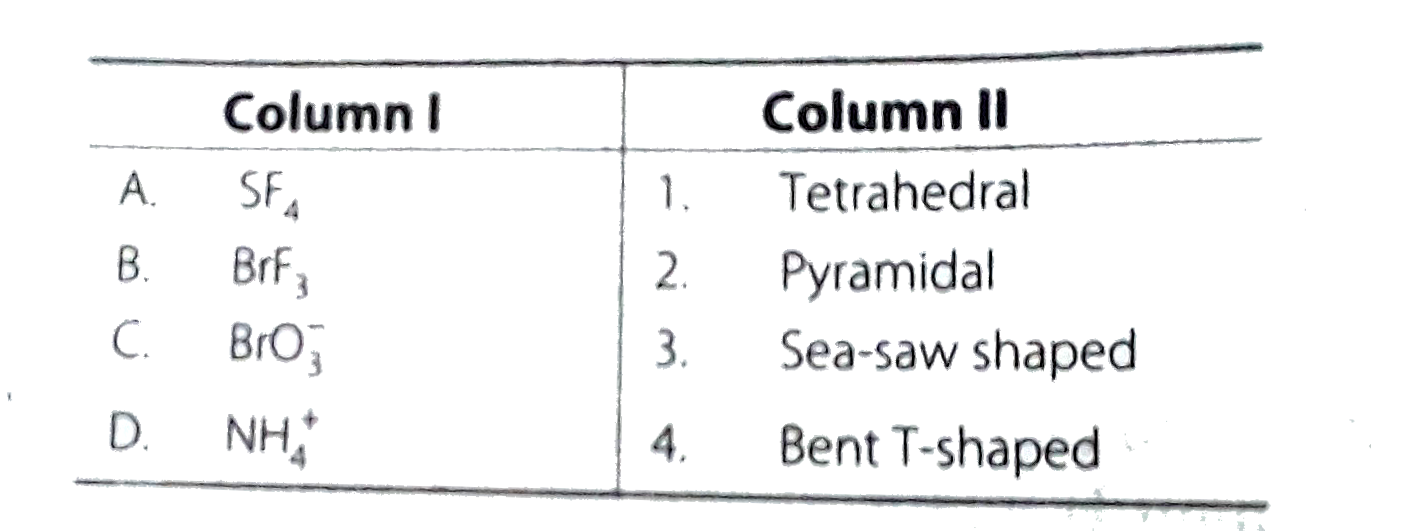Match the species given in Column I with the properties mentioned in Column II
Column-IColumn-IIA.BF−41.Oxidation state of central atom is +4B.AlCl32.Strong oxidising agentC.SnO3.Lewis acidD.PbO24.Can be further oxidised5.Tetrahedral shape
A. BF−4 Tetrahedral shape sp3 hybridisation regular geometry
B. AlCl3− Octet not complete of Al, act as Lewis acid
C. SnOSn2+ can show +4 oxidation state
D. PbO2 Oxidation state of Pb in PbO2 is +4. Due to inert pair effect Pb4+ is less stable than Pb2+, acts as strong oxidising agent.
Topper's Solved these Questions
- THE P-BLOCK ELEMENTSBook:NCERT EXEMPLARChapter:THE P-BLOCK ELEMENTSExercise:Assertion and Reason
Explore 2 Videos
- THE P-BLOCK ELEMENTSBook:NCERT EXEMPLARChapter:THE P-BLOCK ELEMENTSExercise:Long Answer
Explore 10 Videos
- THE P-BLOCK ELEMENTSBook:NCERT EXEMPLARChapter:THE P-BLOCK ELEMENTSExercise:Short Answer
Explore 14 Videos
- STRUCTURE OF ATOMBook:NCERT EXEMPLARChapter:STRUCTURE OF ATOMExercise:All Questions
Explore 53 Videos
- THE S-BLOCK ELEMENTS Book:NCERT EXEMPLARChapter:THE S-BLOCK ELEMENTS Exercise:Long Answer Type Questions
Explore 8 Videos
Similar Questions
Knowledge Check
Match the species given in Column I with the shape given in Column II and mark the correct option.
 AABCD3214BABCD3421CABCD1234DABCD1432
AABCD3214BABCD3421CABCD1234DABCD1432
Match the species given in Column I with the properties mentioned in Column II
Column-IColumn-IIA.BF−41.Oxidation state of central atom is +4B.AlCl32.Strong oxidising agentC.SnO3.Lewis acidD.PbO24.Can be further oxidised5.Tetrahedral shape
View SolutionMatch the statements given in Column I with the oxidation states given in Column II.

View SolutionMatch the statements given in Colunm I with the oxidation states given in Column II.

View SolutionMatch the species given in Column I with the shape given in Column II and mark the correct option.

View SolutionMatch the coordination compounds given in Column I with the central metal atoms given Column II.

View Solution38. Match the shapes given in column- I to their corresponding nets in column-IIColumn-I(shape)Column-II ( Neta)1Viiiiva) a bC) C
View SolutionMatch the types of colloidal systems given in Column I with the name given in Column II.
Column IColumn IIA.Solid in liquid1.FoamB.Liquid in solid 2.SolC.Liquid in liquid 3.GelD.Gas in liquid4.Emulsion
View Solution



